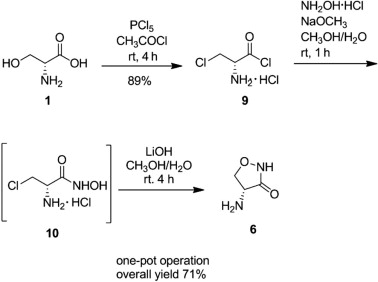Cycloserine production process
Cycloserine can be prepared by fermentation or direct synthesis. The fermentation method produces Actinomyces laven-dulae, and the fermentation medium is dextrin, glucose, starch, soybean cake powder, yeast powder, ammonium sulfate, ammonium nitrate, calcium carbonate, sodium chloride, magnesium sulfate and soybean oil. The synthesis method is to react β-aminooxyalanine ethyl ester dihydrochloride with potassium hydroxide, that is, cyclization to obtain cycloserine.

crafting process
Ingredient ratio
(1) Ethylbenzene: Nitric acid: sulfuric acid: water = 1: 0.618: 1.219: 0.108 (mass ratio)
(2) ethylbenzene nitrate: air: cobalt stearate: manganese acetate = 1: appropriate amount: 0.000533: 0.000533 (mass ratio)
(3) Ethyl ketone acetate: Bromine: Chlorobenzene = 1:0.96: 9.53 (mass ratio)
(4) Bromide: hexamethylenetetramine = 1 : 0.86 (mass ratio)
(5) Salt formation: hydrochloric acid: ethanol = 1: 2.44: 3.12 (mass ratio)
(6) Hydrolyzate: acetic anhydride: sodium acetate = 1: 1.08: 3.8 (mass ratio)
(7) Acetate: Formaldehyde: Methanol = 1: 0.51: 1.25 (mass ratio)
(8) Condensate: Aluminum flakes: isopropanol: aluminum trichloride: hydrochloric acid: water: 10% NaHo = 1: 0.23: 3.62: 0.19: 4.76: 1.25: appropriate amount (mass ratio)
(9) Purified D-amino compound: methyl dichloroacetate: methanol = 1: 0.75: 1.61 (mass ratio)
Process operation
(1). Preparation of p-nitroethylbenzene
First, more than 92% of sulfuric acid is added. Under stirring and cooling, water is added in a fine stream to control the temperature between 40 ° C and 45 ° C. After the addition, the temperature was lowered to 35 ° C, and 96% of nitric acid was continuously added, and the temperature did not exceed 40 ° C. After the addition, cool to 20 ° C.
P-nitroethylbenzene
First add ethylbenzene, add mixed acid at 28 ° C, add, heat 40 ° C ~ 45 ° C, continue to heat for 1 h, so that the reaction is complete.
It was then cooled to 20 ° C and allowed to stand for stratification. The residual acid is washed away with water, the phenol is washed away with alkali, and finally the residual lye is washed away with water. The continuous pressure fractionation pressure was 5.3 × 103 Pa or less, and o-nitroethylbenzene was distilled off at the top. The high-boiling substance distilled from the bottom of the column is subjected to a vacuum distillation to obtain purified p-nitroethylbenzene. Since the boiling point of m-nitroethylbenzene is similar to that of the para-substrate, the p-nitroethylbenzene obtained by rectification still contains 6%. Left and right spacers
(2) Preparation of p-nitroacetophenone
P-nitroethylbenzene was added to the oxidation tower, and cobalt stearate and manganese acetate catalyst (containing carrier calcium carbonate 90%) were added, and the temperature was gradually raised to 150 ° C to excite the reaction, and the reaction was carried out at 135 ° C. When the heat generated by the reaction is gradually reduced, the amount and speed of the generated water are reduced to a certain extent, the reaction is stopped, and the material is released slightly.
A sodium carbonate solution is added according to the acid content of the reactant to convert p-nitrobenzoic acid to a sodium salt. After cooling, filtration and drying, p-nitroacetophenone is obtained.
(3) Preparation of salt
Add p-nitroacetophenone and chlorobenzene to bromine
In the tank, add a small amount of bromine (about 2% to 3% of the total amount). The reaction temperature was maintained at 26 ° C to 28 ° C, and the remaining bromine was gradually added. After the completion of the dropwise addition of bromine, the reaction was continued for 1 hour, and then the temperature was raised to 35 ° C to 37 ° C, and after standing for 0.5 h, the clarified reaction solution was sent to the next step to form a salt reaction.
Add p-nitroacetophenone and chlorobenzene to the bromine canister and add a small amount of bromine (about 2% to 3% of the total amount). The reaction temperature was maintained at 26 ° C to 28 ° C, and the remaining bromine was gradually added. After the completion of the dropwise addition of bromine, the reaction was continued for 1 hour, and then the temperature was raised to 35 ° C to 37 ° C, and after standing for 0.5 h, the clarified reaction solution was sent to the next step to form a salt reaction.
(4) Preparation of p-nitro-α-aminoacetophenone hydrochloride
The dehydrated chlorobenzene was placed in a dry reaction tank, dry hexamethylenetetramine was added, and the reaction liquid of the previous step was added, and the reaction was carried out at 33 ° C to 38 ° C for 1 h, and then the reaction end point was measured. (The reactants are taken a little, filtered, and two portions of hexamethyltetramine in chloroform are added to one portion of the filtrate, and the mixture is heated and shaken. If it is not turbid after cooling, it has reached the end of the reaction).
2) Hydrochloric acid was added to a glass jar, and the temperature was lowered to 7 ° C to 9 ° C to add p-nitro-α-bromoacetophenone hexamethylenetetramine salt. After the conversion to granules, the stirring was stopped, and the mixture was allowed to stand to separate chlorobenzene.
3) Add ethanol, stir the temperature, and react at 32 ° C ~ 34 ° C for 4 h. Further, an appropriate amount of water was added thereto, and the mixture was cooled to -3 ° C, and centrifuged to obtain p-nitro-α-aminoacetophenone hydrochloride.
Send inquiry online For more product information and prices
(Pharmaceutical Ingredients Manufacturer & Supplier & Exporter.)
After sending the online inquiry, we will reply you as soon as possible, if not get any response on time please contact us by Tel or Email. —— Green Stone Swiss
Email: sales@raw-pharmaceutical-materials.comTel: +86 592 5365887
WhatsApp: +86 189 6515 7632
Send inquiry online:

